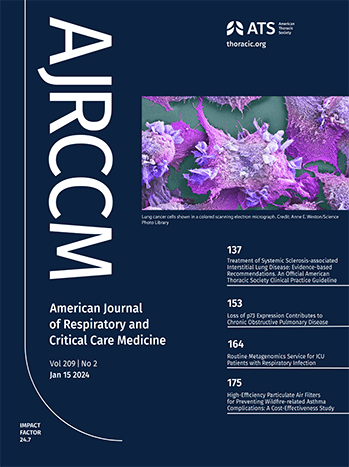社区获得性肺炎的血浆蛋白质组:病理生理学、预后和10年风险。
IF 19.4
1区 医学
Q1 CRITICAL CARE MEDICINE
American journal of respiratory and critical care medicine
Pub Date : 2025-07-02
DOI:10.1164/rccm.202502-0325oc
引用次数: 0
摘要
社区获得性肺炎(CAP)是一个重大的健康负担。目的:绘制CAP患者的血浆蛋白质组图,并将蛋白质丰度与病理生理、组织来源和预后联系起来。方法采用Olink技术(衍生队列)对普通病房收治的CAP患者进行血浆蛋白质组测定。在重症监护病房(ICU)住院的CAP患者和跨护理机构(验证队列)的SARS-CoV-2肺炎患者中进行了额外的Olink测量。在93例CAP病房患者和21例健康对照中分析的2676种蛋白中,904种(33.8%)CAP较高,396种(14.8%)较低,1376种(51.4%)无差异。更丰富的蛋白质与先天免疫和有丝分裂途径相关,主要来源于肺和心脏组织。131个蛋白与临床稳定时间(TCS)相关,其中124个(主要与单核/巨噬细胞和RNA加工相关)与长TCS相关。在88例ICU-CAP患者(1.4- 3.5倍)和305例SARS-CoV-2肺炎患者(1.16- 1.35倍或1.14- 2.65倍)中,非幸存者与幸存者中大多数tcs相关蛋白的丰度存在差异;所有p < 0.05)。在普通人群中(UK Biobank),在10年随访期间,124种与长TCS相关的蛋白中有115种(92.7%)与肺炎风险增加相关,而7种与短TCS相关的蛋白中有6种(85.7%)与肺炎风险降低相关。结论:目前公开的CAP血浆蛋白质组提供了病理生理机制和组织参与的信息,并可能支持个性化治疗的发展。本文章由计算机程序翻译,如有差异,请以英文原文为准。
The Plasma Proteome in Community-acquired Pneumonia: Pathophysiology, Outcome and 10-Year Risk.
RATIONALE
Community-acquired pneumonia (CAP) represents a significant health burden.
OBJECTIVES
We aimed to map the plasma proteome in patients with CAP and associate protein abundance with pathophysiology, tissue source, and outcome.
METHODS
We measured the plasma proteome of CAP patients upon admission to a general ward using Olink technology (derivation cohort). Additional Olink measurements were performed in CAP patients admitted to the intensive care unit (ICU) and SARS-CoV-2 pneumonia patients across care settings (validation cohorts).
MEASUREMENTS AND MAIN RESULTS
Of 2676 proteins analysed in 93 ward-CAP patients and 21 healthy controls, 904 (33.8%) were higher in CAP, 396 (14.8%) lower, and 1376 (51.4%) not different. More abundant proteins were associated with innate immune and mitosis pathways, and mainly originated from lung and cardiac tissue. 131 proteins associated with time to clinical stability (TCS), of which 124 (primarily related to monocyte/macrophage and RNA processing) were connected with a long TCS. Most TCS-associated proteins were differentially abundant in non-survivors versus survivors amongst 88 ICU-CAP (1.4- to 3.5-fold higher) and 305 SARS-CoV-2 pneumonia patients (1.16- to 1.35-fold lower or 1.14- to 2.65-fold higher; all p<0.05). In the general population (UK Biobank), 115 of 124 (92.7%) proteins correlated with long TCS were associated with an increased risk of pneumonia during a 10-year follow-up, while 6 of 7 (85.7%) proteins correlated with shorter TCS were associated with a lower risk of pneumonia.
CONCLUSIONS
This now publicly available CAP plasma proteome provides information on pathophysiological mechanisms and tissue involvement, and may support development of personalised therapies.
求助全文
通过发布文献求助,成功后即可免费获取论文全文。
去求助
来源期刊
CiteScore
27.30
自引率
4.50%
发文量
1313
审稿时长
3-6 weeks
期刊介绍:
The American Journal of Respiratory and Critical Care Medicine focuses on human biology and disease, as well as animal studies that contribute to the understanding of pathophysiology and treatment of diseases that affect the respiratory system and critically ill patients. Papers that are solely or predominantly based in cell and molecular biology are published in the companion journal, the American Journal of Respiratory Cell and Molecular Biology. The Journal also seeks to publish clinical trials and outstanding review articles on areas of interest in several forms. The State-of-the-Art review is a treatise usually covering a broad field that brings bench research to the bedside. Shorter reviews are published as Critical Care Perspectives or Pulmonary Perspectives. These are generally focused on a more limited area and advance a concerted opinion about care for a specific process. Concise Clinical Reviews provide an evidence-based synthesis of the literature pertaining to topics of fundamental importance to the practice of pulmonary, critical care, and sleep medicine. Images providing advances or unusual contributions to the field are published as Images in Pulmonary, Critical Care, Sleep Medicine and the Sciences.
A recent trend and future direction of the Journal has been to include debates of a topical nature on issues of importance in pulmonary and critical care medicine and to the membership of the American Thoracic Society. Other recent changes have included encompassing works from the field of critical care medicine and the extension of the editorial governing of journal policy to colleagues outside of the United States of America. The focus and direction of the Journal is to establish an international forum for state-of-the-art respiratory and critical care medicine.

 求助内容:
求助内容: 应助结果提醒方式:
应助结果提醒方式:


